Modelling and Simulation of the Entrapment of Non-Wetting Fluids Within Disordered Porous Materials
Abstract
1. Introduction
2. Impact of the System Parameters and Physical Constraints
3. Empirical Models
4. Pore Network Models
4.1. Simple Pore Networks
- A throat initially filled with mercury that is also connected to two pore bodies still filled with mercury is emptied via snap-off and the creation of two menisci at the mouths of the throat at each pore body if the critical pressure for snap-off is larger than the applied capillary pressure.
- A throat initially filled with mercury and connected to just one pore body still filled with mercury is emptied through piston-like retraction to the mouth of the throat at that chamber if the applied capillary pressure is lower than the critical pressure for this process.
- For each pore body filled with mercury that is connected to at least one empty throat, mercury will retract from the pore body if the capillary pressure is lower than the critical pressure for retraction from a meniscus of configuration Ii.
4.2. Networks with Wettability Effects
4.3. Dynamic Models
5. Percolation Models
6. Models and Simulations Based upon Imaging Data for the Void Space
6.1. Imaging Modalities and Flow Simulation Techniques
6.2. Use of Magnetic Resonance Imaging (MRI) in Combination with CXT
6.3. Model Construction Using CXT and EM Imaging Data
6.4. Image-Derived Models
7. Thermodynamic and Statistical Mechanical Approaches
8. Discussion
9. Conclusions and Future Perspective
Funding
Institutional Review Board Statement
Informed Consent Statement
Data Availability Statement
Conflicts of Interest
References
- Fetter, C. Contaminant Hydrogeology; Prentice Hall: Hoboken, NJ, USA, 1999. [Google Scholar]
- Kota, A.K.; Kwon, G.; Choi, W.; Mabry, J.M.; Tuteja, A. Hygro-responsive membranes for effective oil-water separation. Nat. Commun. 2012, 3, 1025. [Google Scholar] [CrossRef] [PubMed]
- Ma, J.; Li, Q.; Kühn, M.; Nakaten, N. Power-to-gas based subsurface energy storage: A review. Renew. Sustain. Energy Rev. 2018, 97, 478–496. [Google Scholar] [CrossRef]
- Hyne, N.J. Nontechnical Guide to Petroleum Geology, Exploration, Drilling and Production; PennWell Books, LLC: Tulsa, OK, USA, 2012. [Google Scholar]
- Rigby, S.P.; Alsayah, A.; Seely, R. Impact of Exposure to Supercritical Carbon Dioxide on Reservoir Caprocks and Inter-Layers during Sequestration. Energies 2022, 15, 7538. [Google Scholar] [CrossRef]
- Rigby, S.P. Structural Characterisation of Natural and Industrial Porous Materials: A Manual; Springer International Publishing: Cham, Switzerland, 2020. [Google Scholar]
- Ellman, S.; Mascini, A.; Bultreys, T. Validating mechanistic models of fluid displacement during imbibition. Adv. Water Resour. 2024, 183, 104590. [Google Scholar] [CrossRef]
- Blunt, M.J. Multiphase Flow in Permeable Media: A Pore-Scale Perspective; Cambridge University Press: Cambridge, UK, 2017. [Google Scholar]
- Aziz, R.; Nisar, V.; Erfani, H.; Martinez-Ferrer, P.J. Impact of pore morphology on two-phase flow dynamics under wettability alteration. Fuel 2020, 268, 117315. [Google Scholar] [CrossRef]
- Al-Gharbi, M.S.; Blunt, M.J. Dynamic network modeling of two-phase drainage in porous media. Phys. Rev. E 2005, 71, 016308. [Google Scholar] [CrossRef]
- Rigby, S.P.; Chigada, P.I.; Evbuomvan, I.O.; Chudek, J.A.; Miri, T.; Wood, J.; Bakalis, S. Experimental and modelling studies of the kinetics of mercury retraction from highly confined geometries during porosimetry in the transport and the quasi-equilibrium regimes. Chem. Eng. Sci. 2008, 63, 5771–5788. [Google Scholar] [CrossRef]
- Mason, G.; Morrow, N.R. Developments in spontaneous imbibition and possibilities for future work. J. Pet. Sci. Eng. 2013, 110, 268–293. [Google Scholar] [CrossRef]
- Weisberg, M. Simulation and Similarity: Using Models to Understand the World; Oxford University Press: Oxford, UK, 2013. [Google Scholar]
- Rigby, S.P. Do Pores Exist?—Foundational Issues in Pore Structural Characterisation. Foundations 2024, 4, 225–248. [Google Scholar] [CrossRef]
- Rigby, S.P.; Himona, E. Methods of Pore Structural Characterisation of Sedimentary Rocks and Their Constituent Minerals. Minerals 2024, 14, 756. [Google Scholar] [CrossRef]
- Miller, C.T.; Christakos, G.; Imhoff, P.T.; McBride, J.F.; Pedit, J.A.; Trangenstein, J.A. Multiphase flow and transport modeling in heterogeneous porous media: Challenges and approaches. Adv. Water Resour. 1998, 21, 77–120. [Google Scholar] [CrossRef]
- Elhaj, M.A.; Niah, M.I.; Hossain, M.E. State-of-the-art on capillary pressure hysteresis: Productive techniques for better reservoir performance. Upstream Oil Gas Technol. 2021, 7, 100040. [Google Scholar] [CrossRef]
- Lan, Y.; Guo, P.; Liu, Y.; Wang, S.; Cao, S.; Zhang, J.; Sun, W.; Qi, D.; Ji, Q. State of the art relative permeability hysteresis in porous media: Petroleum engineering applications. Appl. Sci. 2024, 14, 46396. [Google Scholar] [CrossRef]
- Gong, Y.; Sedghi, M.; Piri, M. Dynamic pore-scale modelling of residual trapping following imbibition in a rough-walled fracture. Transp. Porous Media 2021, 140, 143–179. [Google Scholar] [CrossRef]
- Land, C.S. Calculation of imbibition relative permeability for two- and three-phase flow from rock properties. SPE J. 1968, 8, 149–156. [Google Scholar] [CrossRef]
- Salmas, C.E.; Androutsopoulos, G.P. A novel pore structure tortuosity concept based on nitrogen sorption hysteresis data. Ind. Eng. Chem. Res. 2001, 40, 721–730. [Google Scholar] [CrossRef]
- Rigby, S.P.; Hasan, M.; Hitchcock, I.; Fletcher, R.S. Detection of the delayed condensation effect and determination of its impact on the accuracy of gas adsorption pore size distributions. Colloids Surf. A 2017, 517, 33–44. [Google Scholar] [CrossRef]
- Moghadasi, R.; Foroughi, S.; Goodarzi, S.; Zhang, Y.; Bijeljic, B.; Blunt, M.J.; Niemi, A. Trapping and remobilization during geological CO2 storage: A pore-scale imaging and modeling study. Adv. Water Resour. 2025, 205, 105092. [Google Scholar] [CrossRef]
- Androutsopoulos, G.P.; Mann, R. Evaluation of mercury porosimeter experiments using a network pore structure model. Chem. Eng. Sci. 1979, 34, 1203–1212. [Google Scholar] [CrossRef]
- Mann, R.; Allamy, A.; Holt, A. Visualized porosimetry for pore structure characterization of a nickel/alumina reforming catalyst. Chem. Eng. Res. Des. 1995, 73, 147–153. [Google Scholar]
- Mata, V.G.; Lopes, J.C.B.; Dias, M.M. Porous media characterization using mercury porosimetry simulation. 1. Description of the simulator and its sensitivity to model parameters. Ind. Eng. Chem. Res. 2001, 40, 3511–3522. [Google Scholar] [CrossRef]
- Mata, V.G.; Lopes, J.C.B.; Dias, M.M. Porous media characterization using mercury porosimetry simulation. 2. An iterative method for the determination of the real pore size distribution and the mean coordination number. Ind. Eng. Chem. Res. 2001, 40, 4836–4843. [Google Scholar] [CrossRef]
- Portsmouth, R.L.; Gladden, L.F. Determination of pore connectivity by mercury porosimetry. Chem. Eng. Sci. 1991, 46, 3023–3036. [Google Scholar] [CrossRef]
- Portsmouth, R.L.; Gladden, L.F. Mercury porosimetry as a probe of pore connectivity. Chem. Eng. Res. Des. 1992, 70, 63–70. [Google Scholar]
- Wardlaw, N.C.; McKellar, M. Mercury porosimetry and the interpretation of pore geometry in sedimentary rocks and artificial models. Powder Technol. 1981, 29, 127–143. [Google Scholar] [CrossRef]
- Dong, M.; Dullien, F.A.L.; Dai, L.; Li, D. Immiscible displacement in the interacting capillary bundle model part I. Development of interacting capillary bundle model. Trans. Porous Med. 2005, 59, 1–18. [Google Scholar] [CrossRef]
- Dong, M.; Dullien, F.A.L.; Dai, L.; Li, D. Immiscible displacement in the interacting capillary bundle model part II. Applications of model and comparison of interacting and non-interacting capillary bundle models. Trans. Porous Med. 2006, 63, 289–304. [Google Scholar] [CrossRef]
- Meng, Q.; Liu, H.; Wang, J. Entrapment of the non-wetting phase during co-current spontaneous imbibition. Energy Fuels 2015, 29, 686–694. [Google Scholar] [CrossRef]
- Wang, J.; Dong, M. Trapping of the non-wetting phase in an interacting triangular tube bundle model. Chem. Eng. Sci. 2011, 66, 250–259. [Google Scholar] [CrossRef]
- Felipe, C.; Cordero, S.; Kornhauser, I.; Zgrablich, G.; López, R.; Rojas, F. Domain Complexion Diagrams Related to Mercury Intrusion-Extrusion in Monte Carlo-Simulated Porous Networks. Part. Part. Syst. Charact. 2006, 23, 48–60. [Google Scholar] [CrossRef]
- Tsakiroglou, C.D.; Payatakes, A.C. A new simulator of mercury porosimetry for the characterization of porous materials. J. Colloid Interface Sci. 1990, 137, 315–339. [Google Scholar] [CrossRef]
- Tsakiroglou, C.D.; Payatakes, A.C. Mercury intrusion and retraction in model porous media. Adv. Colloid Interface Sci. 1998, 75, 215–253. [Google Scholar] [CrossRef]
- Tian, Y.; Ju, B.; Chen, X.; Chen, Z.; Dong, Y.; Wu, D. Pore-scale investigation of waterflooding based on experiments and numerical simulations considering the change in geometry and wettability. Energy Fuels 2021, 35, 17617–17628. [Google Scholar] [CrossRef]
- Pavuluri, S.; Seers, T.D.; Shokri, N.; Alyafei, N.; Rabbani, H.S. Capillary trapping in mixed-wet porous media: Implications for subsurface carbon dioxide sequestration. Int. J. Multiph. Flow 2025, 191, 105307. [Google Scholar] [CrossRef]
- Wolf, F.G.; Siebert, D.N.; Surmas, R. Influence of wettability on the residual fluid saturation for homogeneous and heterogeneous systems. Phys. Fluids 2020, 32, 052008. [Google Scholar] [CrossRef]
- Liu, Q.; Song, R.; Liu, J.; Lei, Y.; Zhu, X. Pore-scale visualization and quantitative analysis of the spontaneous imbibition based on experiments and micro-CT technology in low-permeability mixed-wettability rock. Energy Sci. Eng. 2020, 8, 1840–1856. [Google Scholar] [CrossRef]
- Liu, Q.; Li, J.; Liang, B.; Liu, J.; Sun, W.; He, J.; Lei, Y. Complex wettability behaviour triggering mechanism on imbibition: A model construction and comparative study based on analysis at multiple scales. Energy 2023, 275, 127434. [Google Scholar] [CrossRef]
- Watson, M.G.; Bondino, J.; Hamon, G.; McDougall, S.R. A pore-scale investigation of low-salinity waterflooding in porous media: Uniformly wetted systems. Transp. Porous Media 2017, 118, 201–223. [Google Scholar] [CrossRef]
- Raeesi, B.; Piri, M. The effects of wettability and trapping on relationships between interfacial area, capillary pressure and saturation in porous media: A pore-scale network modelling approach. J. Hydrol. 2009, 376, 337–352. [Google Scholar] [CrossRef]
- Stauffer, D.; Aharony, A. Introduction to Percolation Theory, 2nd ed.; Taylor & Francis: London, UK, 2017. [Google Scholar]
- Avnir, D. The Fractal Approach to Heterogeneous Chemistry; Wiley: New York, NY, USA, 1989. [Google Scholar]
- Larson, R.G.; Scriven, L.E.; Davis, H.T. Percolation theory of two phase flow in porous media. Chem. Eng. Sci. 1981, 36, 57–73. [Google Scholar] [CrossRef]
- Ioannidis, M.A.; Chatzis, I. A mixed-percoaltion model of capillary hysteresis and entrapment in mercury porosimetry. J. Colloid Interface Sci. 1993, 161, 278–291. [Google Scholar] [CrossRef]
- Leonormand, R.; Zarone, C.; Sarr, A. Mechanisms of The Displacement of One Fluid by Another in a Network of Capillary Ducts. J. Fluid Mech. 1983, 135, 337–353. [Google Scholar] [CrossRef]
- Ioannidis, M.A.; Chatzis, I. The effect of spatial correlations on the accessibility characteristics of three-dimensional cubic networks as related to drainage displacements in porous media. Water Resour. Res. 1993, 29, 1777–1785. [Google Scholar] [CrossRef]
- Mahmud, W.M.; Nguyen, V.H. Effects of snap-off in imbibition in porous media with different spatial correlations. Transp. Porous Media 2006, 64, 279–300. [Google Scholar] [CrossRef]
- Ben-Avraham, D.; Havlin, S. Diffusion and Reactions in Fractals and Disordered Systems; Cambridge University Press: Cambridge, UK, 2000. [Google Scholar]
- Rodenas, T.; Prieto, G. FIB-SEM tomography in catalysis and electrochemistry. Catal. Today 2022, 405–406, 2–13. [Google Scholar] [CrossRef]
- Liu, Q.; Sun, M.; Sun, X.; Liu, B.; Ostadhassan, M.; Huang, W.; Chen, X.; Pan, Z. Pore network characterization of shale reservoirs through state-of-the-art X-ray computed tomography: A review. Gas Sci. Eng. 2023, 113, 204967. [Google Scholar] [CrossRef]
- Cai, J.; Qin, X.; Wang, H.; Xia, Y.; Zou, S. Pore-scale investigation of forced imbibition in porous rocks through interface curvature and pore topology analysis. J. Rock Mech. Geotech. Eng. 2025, 17, 245–257. [Google Scholar] [CrossRef]
- Namaee-Ghasemi, A.; Ayatollahi, S.; Mahani, H. Pore-scale simulation of the interplay between wettability, capillary number, and salt dispersion on the efficiency of oil mobilization by low-salinity waterflooding. SPE J. 2021, 26, 4000–4021. [Google Scholar] [CrossRef]
- Meng, Q.; Zhao, L.; Li, P.; Yang, F.; Cai, J. Experiments and phase-field simulation of counter-current imbibition in porous media with different pore structure. J. Hydrol. 2022, 608, 127670. [Google Scholar] [CrossRef]
- Wang, W.; Xie, Q.; Wang, H.; Su, Y.; Rezaei-Gomari, S. Pseudopotential-based multiple-relaxation-time lattice Boltzmann model for multicomponent and multiphase slip flow. Adv. Geo-Energy Res. 2023, 9, 106–116. [Google Scholar] [CrossRef]
- Suwandi, N.; Jiang, F.; Tsuji, T. Relative permeability variation depending on viscosity ratio and capillary number. Water Resour. Res. 2022, 58, e2021WR031501. [Google Scholar] [CrossRef]
- Ashirbekov, A.; Kabdenova, B.; Kuljabekov, A.; Monaco, E.; Wang, L.; Rojas-Solórzano, L. Lattice Boltzmann pseudopotential multiphase modeling of transcritical CO2 flow using a crossover formulation. Adv. Geo-Energy Res. 2022, 6, 539–540. [Google Scholar] [CrossRef]
- Ambekar, A.S.; Mondal, S.; Buwa, V.V. Pore-resolved volume-of-fluid simulations of two-phase flow in porous media: Pore-scale flow mechanisms and regime map. Phys. Fluids 2022, 33, 102119. [Google Scholar] [CrossRef]
- Yang, Y.; Cai, S.; Yao, J.; Zhong, J.; Zhang, K.; Song, W.; Zhang, L.; Sun, H.; Lisitsa, V. Pore-scale simulation of remaining oil distribution in 3D porous media affected by wettability and capillarity based upon volume of fluid method. Int. J. Multiph. Flow 2021, 143, 103746. [Google Scholar] [CrossRef]
- Arif, M.; Mahmoud, Y.; Zhang, S.; Iglauer, S. X-ray tomography imaging of shale microstructures: A review in the context of multiscale correlative imaging. Int. J. Coal Geol. 2020, 233, 103641. [Google Scholar] [CrossRef]
- Ma, L.; Dowey, P.J.; Rutter, E.; Taylor, K.G.; Lee, P.D. A novel upscaling procedure for characterising heterogeneous shale porosity from nanometer-to millimetre-scale in 3D. Energy 2019, 181, 1285–1297. [Google Scholar] [CrossRef]
- Koster, A.J.; Ziese, U.; Verkleij, A.J.; Janssen, A.H.; de Jong, K.P. Three-dimensional transmission electron microscopy: A novel imaging and characterization technique with nanometer scale resolution for materials science. J. Phys. Chem. B 2000, 104, 9368–9370. [Google Scholar] [CrossRef]
- Nepryahin, A.; Fletcher, R.; Holt, E.M.; Rigby, S.P. Structure-transport relationships in disordered solids using integrated rate of gas sorption and mercury porosimetry. Chem. Eng. Sci. 2016, 152, 663–673. [Google Scholar] [CrossRef]
- Hollewand, M.P.; Gladden, L.F. Heterogeneities in Structure and Diffusion within Porous Catalyst Support Pellets Observed by NMR Imaging. J. Catal. 1993, 144, 254–272. [Google Scholar] [CrossRef]
- Rigby, S.P.; Watt-Smith, M.J.; Chigada, P.; Chudek, J.A.; Fletcher, R.S.; Wood, J.; Bakalis, S.; Miri, T. Studies of the entrapment of non-wetting fluid within nanoporous media using a synergistic combination of MRI and micro-computed X-ray tomography. Chem. Eng. Sci. 2006, 61, 7579–7592. [Google Scholar] [CrossRef]
- Watt-Smith, M.J.; Rigby, S.P.; Chudek, J.A.; Fletcher, R.S. Simulation of non-wetting phase entrapment within porous media using MRI. Langmuir 2006, 22, 5180–5188. [Google Scholar] [CrossRef]
- Rigby, S.P. A hierarchical structural model for the interpretation of mercury porosimetry and nitrogen sorption. J. Colloid Interface Sci. 2000, 224, 382–396. [Google Scholar] [CrossRef]
- Sok, R.M.; Knackstedt, M.A.; Sheppard, A.P.; Pinczewski, W.V.; Lindquist, W.B.; Venkatarangan, A.; Paterson, L. Direct and stochastic generation of network models from tomographic images: Effect of topology on residual saturations. Transp. Porous Media 2002, 46, 345–372. [Google Scholar] [CrossRef]
- Jackson, S.J.; Niu, Y.; Manoorkar, S.; Mostaghimi, P.; Armstrong, R.T. Deep Learning of Multiresolution X-Ray Micro-Computed-Tomography Images for Multiscale Modeling. Phys. Rev. Appl. 2022, 17, 054046. [Google Scholar] [CrossRef]
- Huang, Y.; Xiang, Z.; Qian, M. Deep-learning-based porous media microstructure quantitative characterization and reconstruction method. Phys. Rev. E 2022, 105, 015308. [Google Scholar] [CrossRef]
- Aghaei, A.; Piri, M. Direct pore-to-core up-scaling of displacement processes: Dynamic pore network modelling and experimentation. J. Hydrol. 2015, 522, 488–509. [Google Scholar] [CrossRef]
- Hyväluoma, J.; Raiskinmäki, P.; Jäsberg, A.; Koponen, A.; Kataja, M.; Timonen, J. Evaluation of a lattice-Boltzmann method for mercury intrusion porosimetry simulations. Future Gener. Comput. Syst. 2004, 20, 1003–1011. [Google Scholar] [CrossRef]
- Shams, M.; Singh, K.; Bijeljic, B.; Blunt, M.J. Direct numerical simulation of pore-scale trapping events during capillary-dominated two-phase flow in porous media. Transp. Porous Media 2021, 138, 443–458. [Google Scholar] [CrossRef]
- Zhang, Q.; Yang, Y.; Wang, D.; Sun, H.; Zhong, J.; Yao, J.; Lisitsa, V. Correlations of residual oil distribution with pore structure during the water flooding process in sandstone reservoirs. Adv. Geo-Energy Res. 2024, 12, 113–126. [Google Scholar] [CrossRef]
- Bultreys, T.; Lin, Q.; Gao, Y.; Raeini, A.Q.; AlRatrout, A.; Bijeljic, B.; Blunt, M.J. Validation of model predictions of pore-scale fluid distributions during two-phase flow. Phys. Rev. E 2018, 97, 053104. [Google Scholar] [CrossRef]
- Bultreys, T.; Singh, K.; Raeini, A.Q.; Ruspini, L.C.; Øren, P.E.; Berg, S.; Rücker, M.; Bijeljic, B.; Blunt, M.J. Verifying pore network models of imbibition in rocks using time-resolved synchrotron imaging. Water Resour. Res. 2020, 56, 1–23. [Google Scholar] [CrossRef]
- Lowell, S.; Shields, J.E. Influence of pore potential on hysteresis and entrapment in mercury porosimetry. J. Colloid Interface Sci. 1982, 90, 203–211. [Google Scholar] [CrossRef]
- Porcheron, F.; Monson, P.A. Modeling mercury porosimetry using statistical mechanics. Langmuir 2004, 20, 6482–6489. [Google Scholar] [CrossRef] [PubMed]
- Porcheron, F.; Monson, P.A. Dynamic aspects of mercury porosimetry: A lattice model study. Langmuir 2005, 21, 3179–3186. [Google Scholar] [CrossRef] [PubMed]
- Porcheron, F.; Thommes, M.; Ahmad, R.; Monson, P.A. Mercury porosimetry in mesoporous glasses: A comparison of experiments with results from a molecular model. Langmuir 2007, 23, 3372–3380. [Google Scholar] [CrossRef]
- Ruffino, L.; Mann, R.; Oldman, R.; Stitt, E.H.; Boller, E.; Cloetens, P.; DiMichiel, M.; Merino, J. Using x-ray microtomography for characterisation of catalyst particle pore structure. Can. J. Chem. Eng. 2005, 83, 132–139. [Google Scholar] [CrossRef]
- Alpak, F.O.; Zacharoudiou, I.; Dietderich, J.; Saxena, N. Direct simulation of pore-scale two-phase visco-capillary flow on large digital rock images using a phase-field lattice Boltzmann method on general purpose graphics processing units. Comput. Geosci. 2019, 23, 849–880. [Google Scholar] [CrossRef]
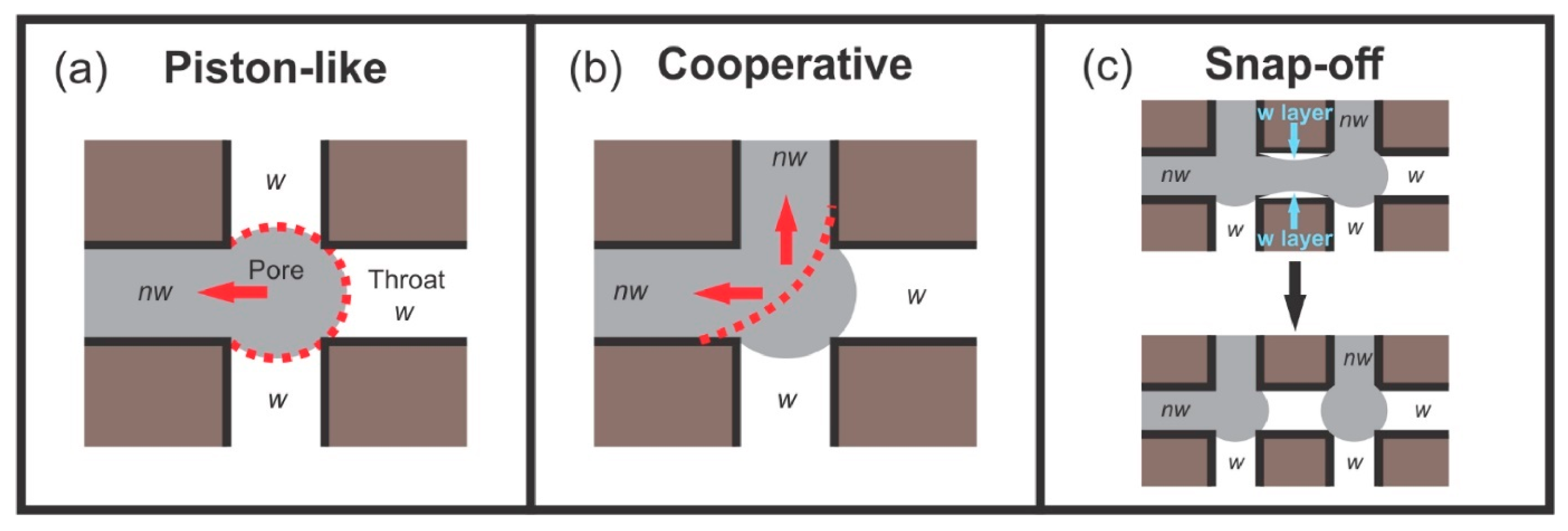

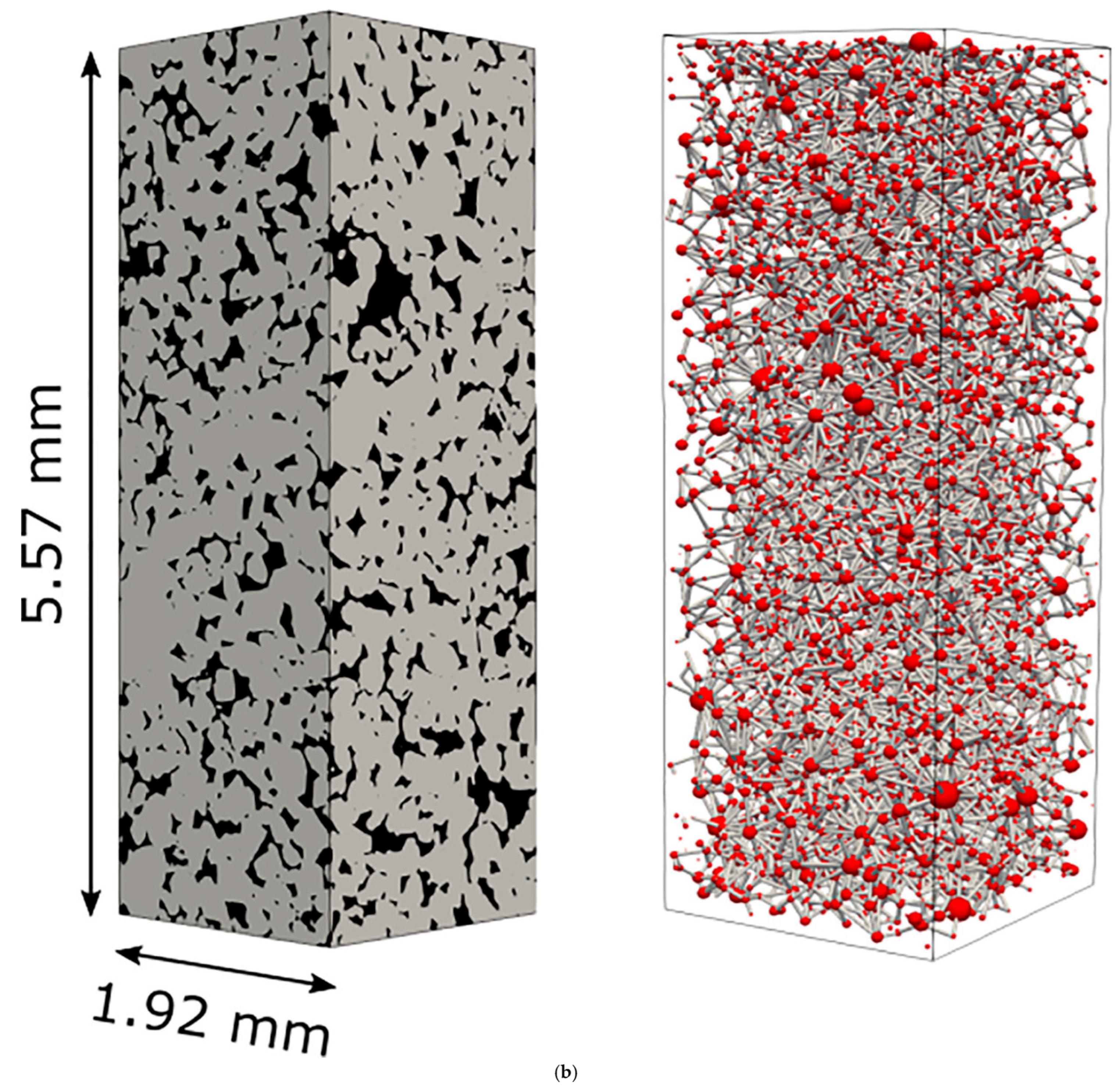





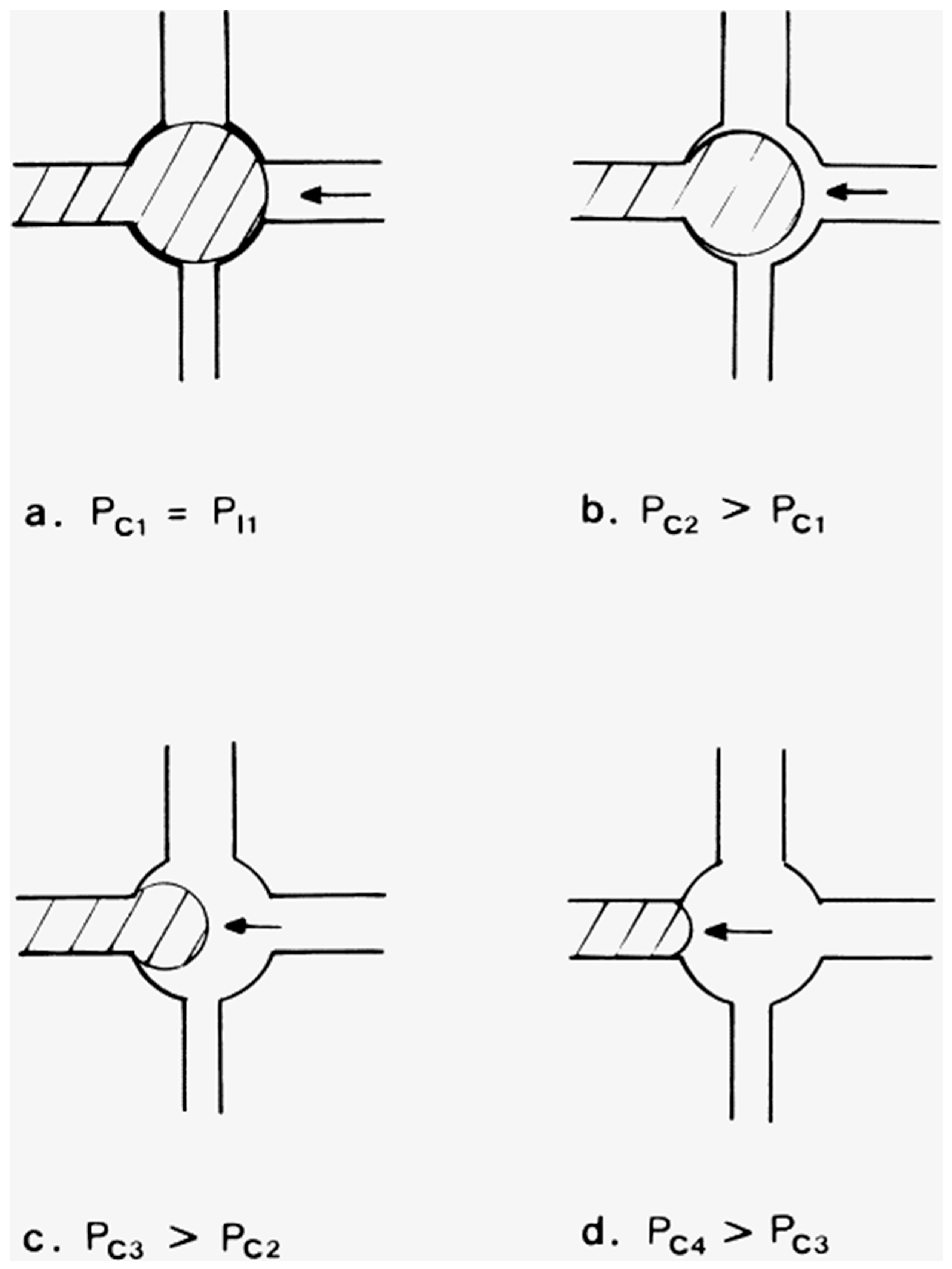
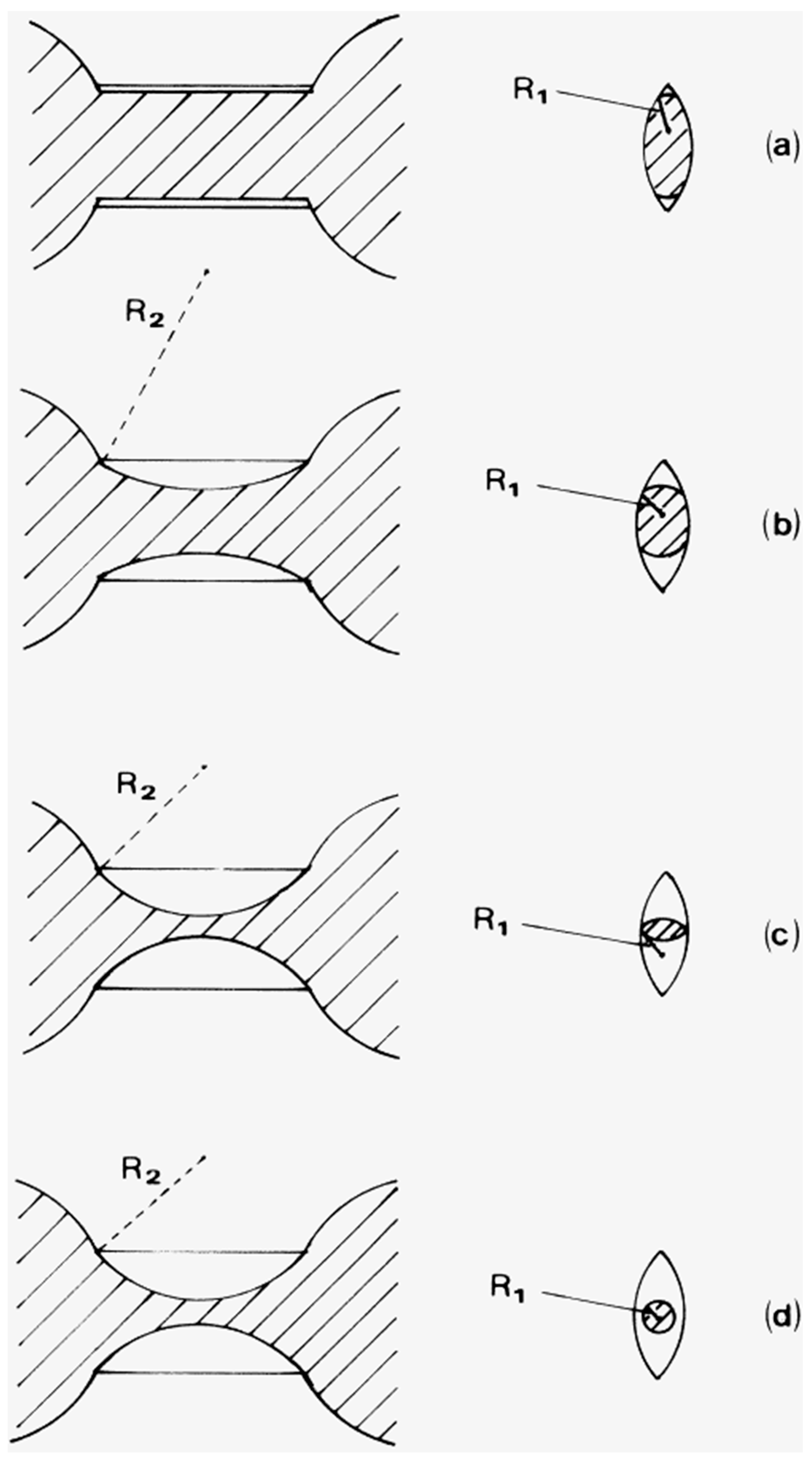

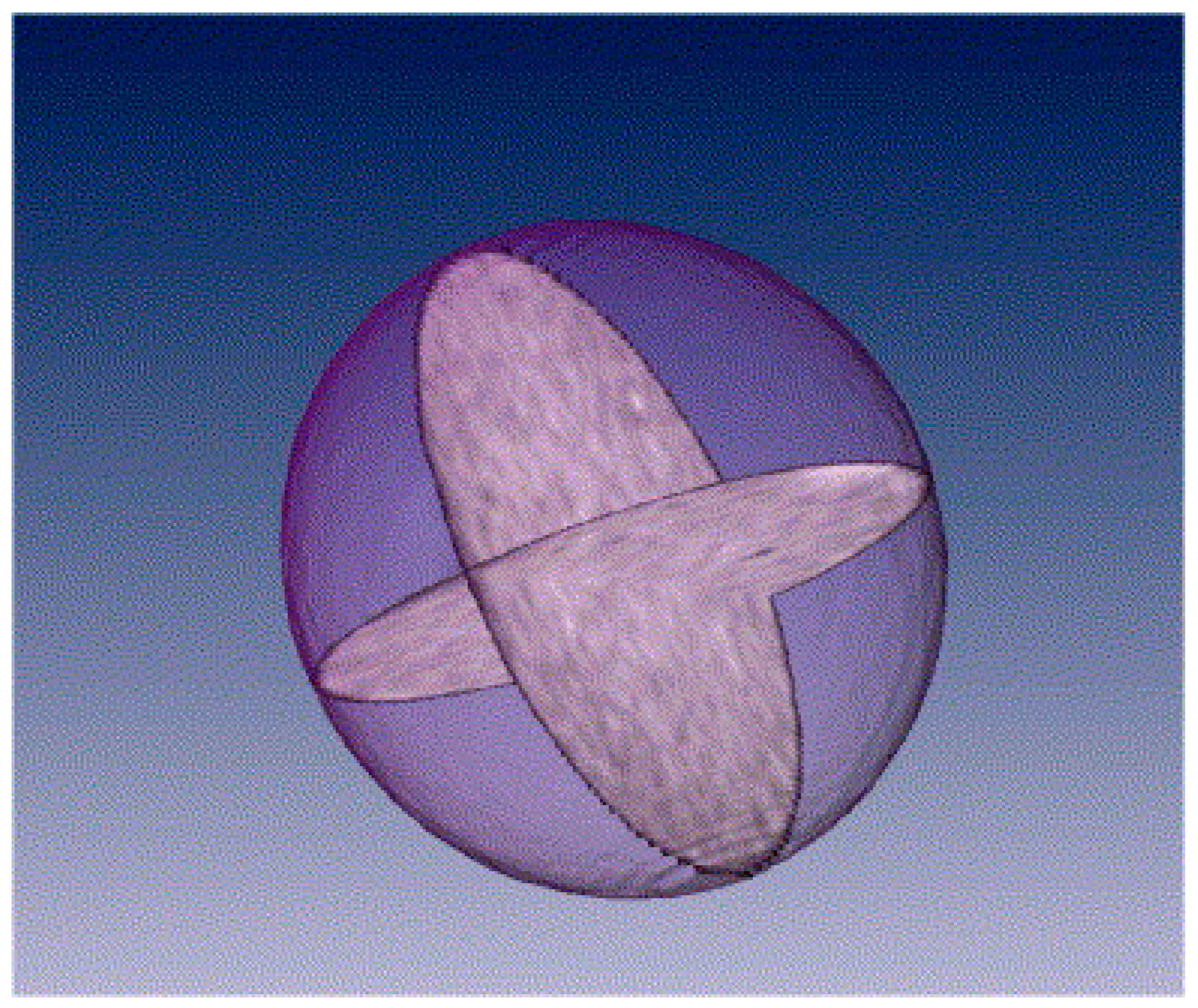
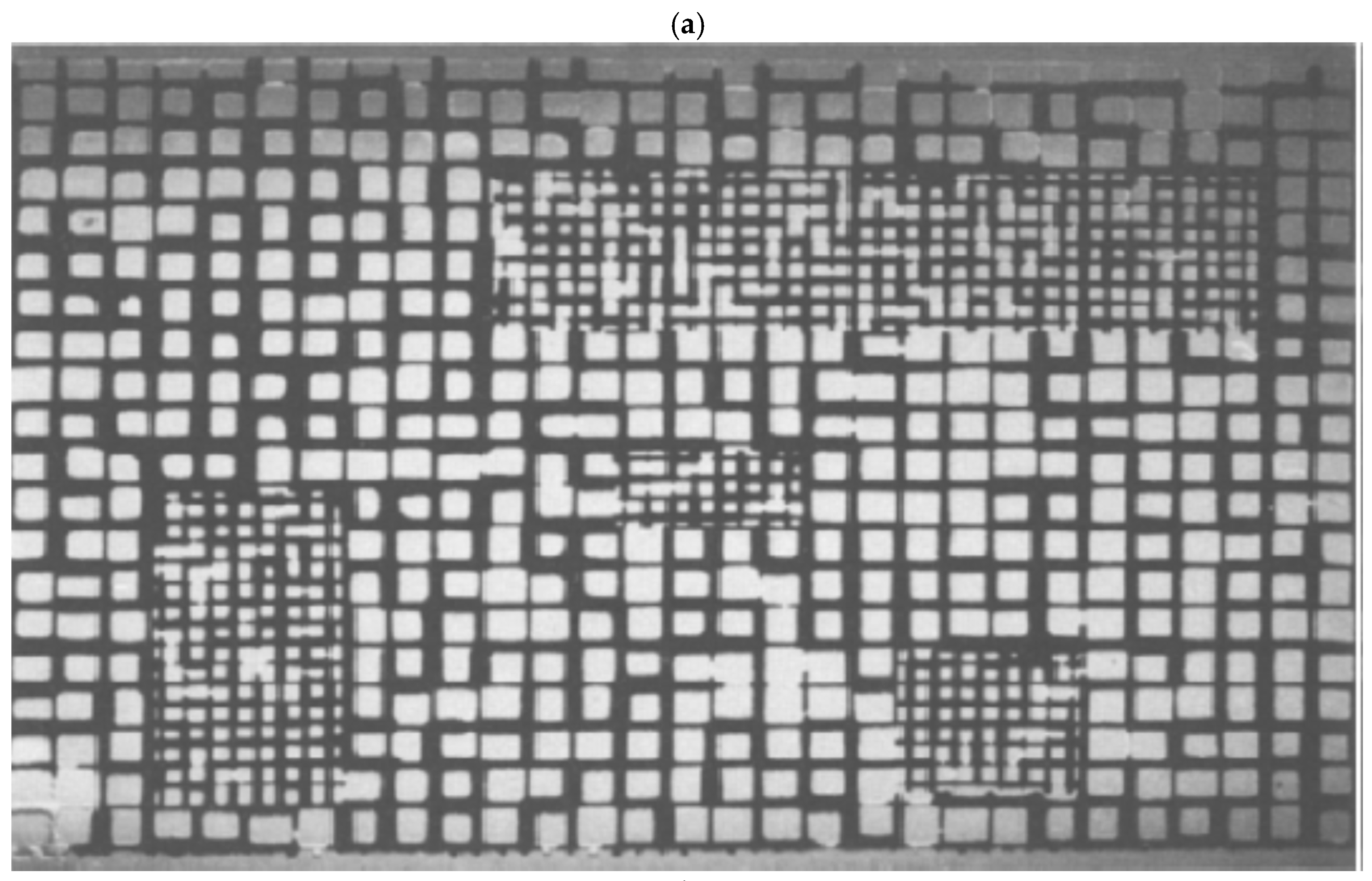
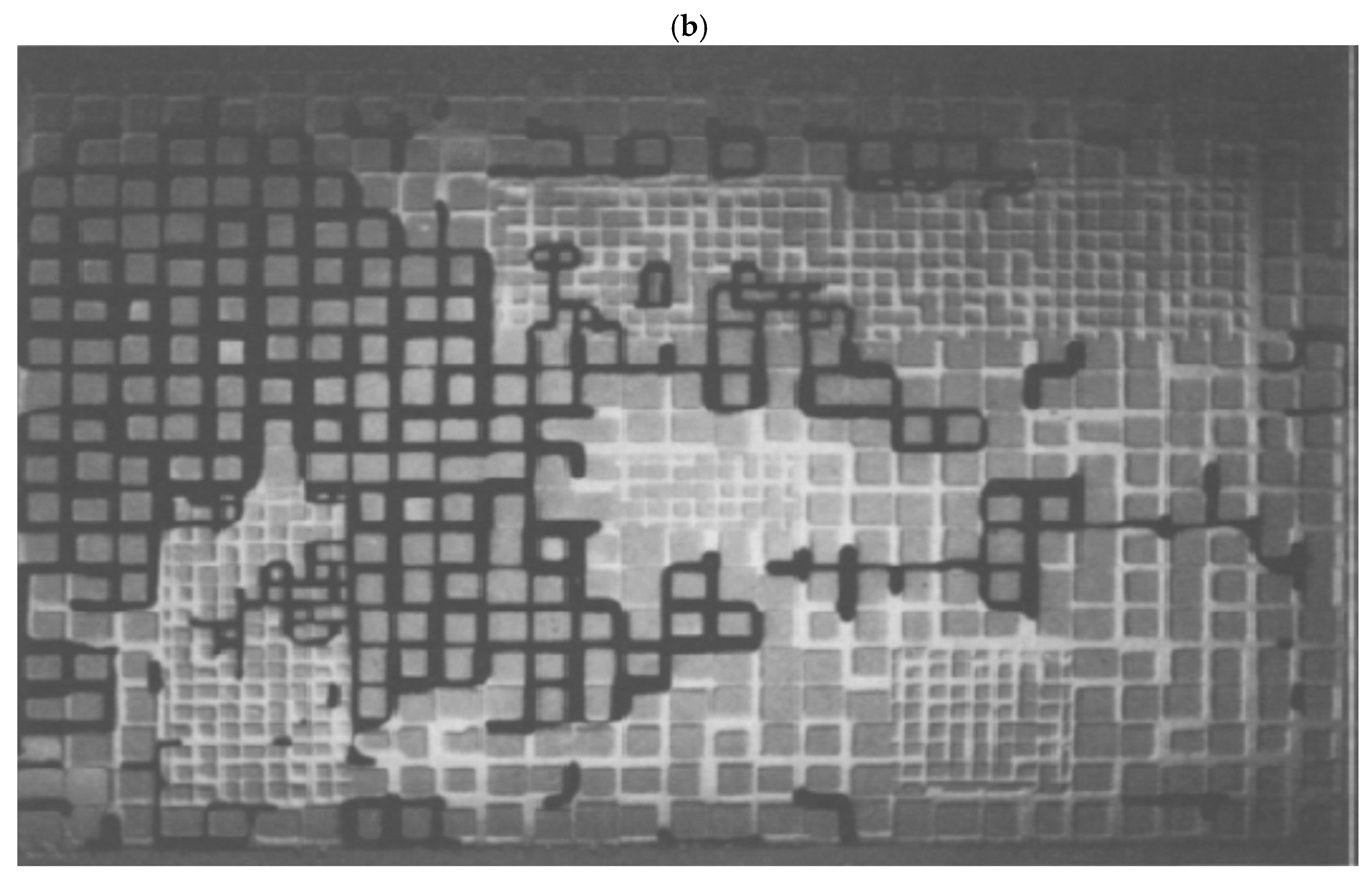

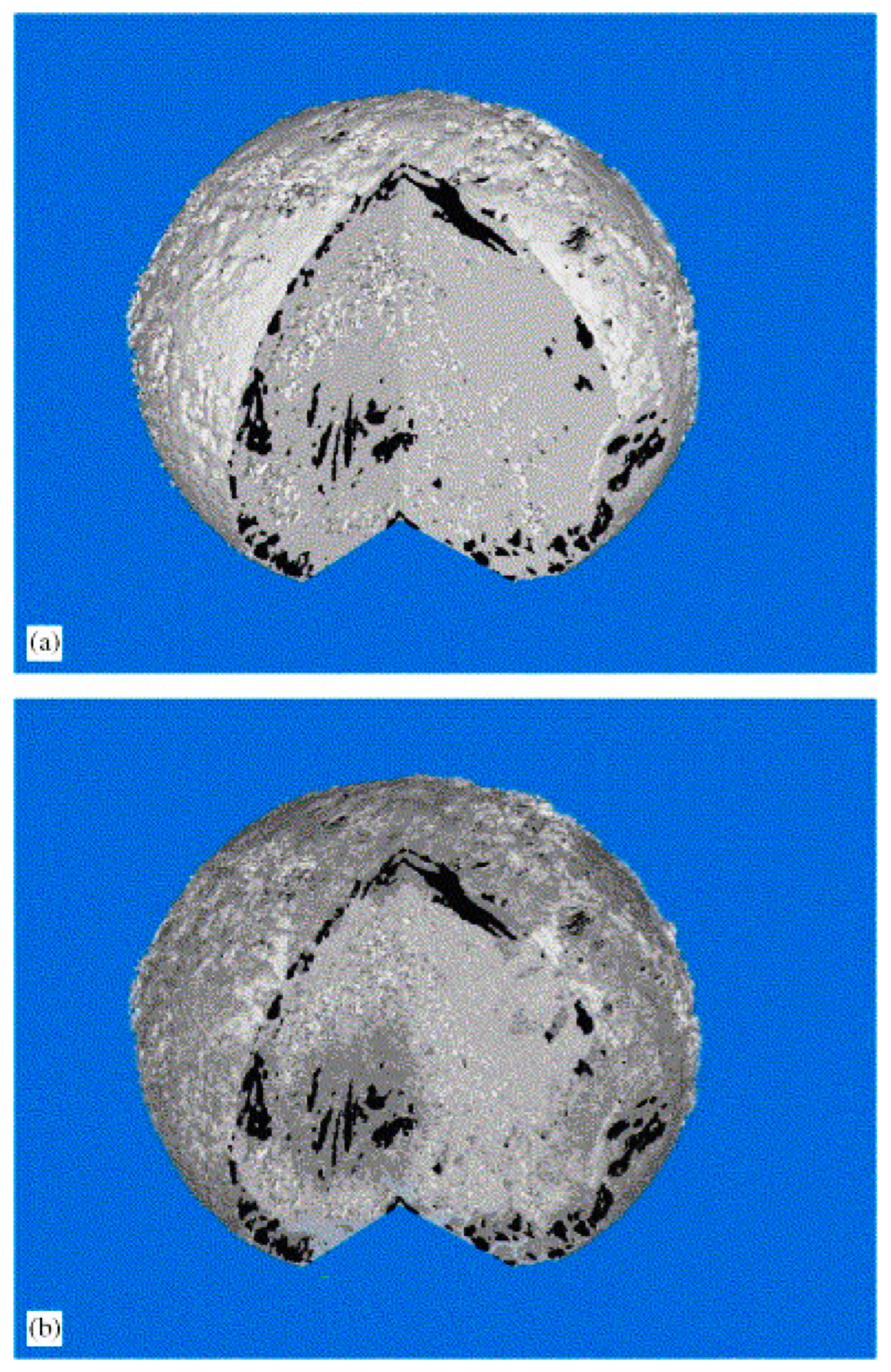




Disclaimer/Publisher’s Note: The statements, opinions and data contained in all publications are solely those of the individual author(s) and contributor(s) and not of MDPI and/or the editor(s). MDPI and/or the editor(s) disclaim responsibility for any injury to people or property resulting from any ideas, methods, instructions or products referred to in the content. |
© 2025 by the author. Licensee MDPI, Basel, Switzerland. This article is an open access article distributed under the terms and conditions of the Creative Commons Attribution (CC BY) license (https://creativecommons.org/licenses/by/4.0/).
Share and Cite
Rigby, S.P. Modelling and Simulation of the Entrapment of Non-Wetting Fluids Within Disordered Porous Materials. Fluids 2025, 10, 286. https://doi.org/10.3390/fluids10110286
Rigby SP. Modelling and Simulation of the Entrapment of Non-Wetting Fluids Within Disordered Porous Materials. Fluids. 2025; 10(11):286. https://doi.org/10.3390/fluids10110286
Chicago/Turabian StyleRigby, Sean P. 2025. "Modelling and Simulation of the Entrapment of Non-Wetting Fluids Within Disordered Porous Materials" Fluids 10, no. 11: 286. https://doi.org/10.3390/fluids10110286
APA StyleRigby, S. P. (2025). Modelling and Simulation of the Entrapment of Non-Wetting Fluids Within Disordered Porous Materials. Fluids, 10(11), 286. https://doi.org/10.3390/fluids10110286





